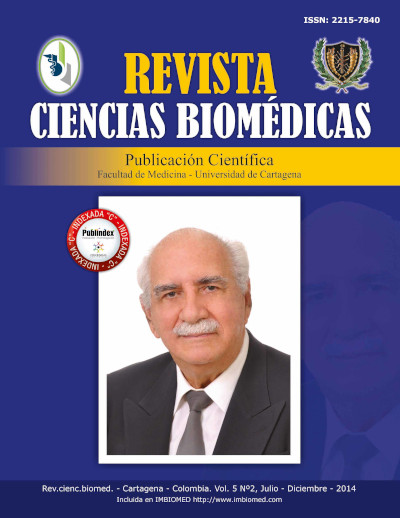Desempeño psicométrico de la escala para homofobia en estudiantes de medicina
Desempeño psicométrico de la escala para homofobia en estudiantes de medicina
Contenido principal del artículo
Resumen
Introducción: el prejuicio sexual (homofobia) cobró mayor atención en las ciencias biomédicas y sociales en el marco de la epidemia por VIH. La Escala para Homofobia (EHF) es uno de los instrumentos más breves para la cuantificación de este constructo.
Objetivo: observar algunos indicadores de validez y confiabilidad de EHF en estudiantes
de medicina de una universidad de Bucaramanga, Colombia.
Método: estudio de validación. Participaron 366 estudiantes entre 18 y 30 años de edad (M=20.1, DE=1.9). El grupo femenino representó 59.1% de la participación. Se estimaron medidas de validez (análisis factorial exploratorio, correlaciones para validez convergente y divergente y funcionamiento diferencial de ítems según sexo) y de confiabilidad (alfa de Cronbach y omega de McDonald).
Resultado: se observó un factor que explicó el 43.8% de la varianza, alta validez convergente
y divergente (r=0.82 y 0.03, respectivamente), y un funcionamiento diferencial de ítems sin impacto por sexo. Alfa de Cronbach 0.78 y omega de McDonald 0.79.
Conclusión: EHF presenta alta validez de constructo, convergente, divergente, sin funcionamiento diferencial de los ítems según sexo y buena confiabilidad tipo consistencia
interna. Rev.cienc.biomed. 2014;5(2):287-294.
Descargas
Datos de publicación
Perfil evaluadores/as N/D
Declaraciones de autoría
- Sociedad académica
- Universidad de Cartagena
- Editorial
- Universidad de Cartagena
Detalles del artículo
Referencias (VER)
Ahmad S, Bhugra D. Homophobia: an updated review of the literature. Sex Relation Ther. 2010;25(4):447-455.
Herek GM. The psychology of sexual prejudice. Curr Direction Psychol Sci. 2000;9:X 19-22.
Link BG, Phelan JC. Conceptualizing stigma. Ann Rev Sociol. 2001;27:363-385.
Major B, O’Brien LT. The social psychology of stigma. Ann Rev Psychol. 2005;56: 393-421.
Phelan JC, Link BG, Dovidio JF. Stigma and prejudice: one animal or two? Soc Sci Med. 2008;67(3):358-367.
Hatzenbuehler ML, Phelan JC, Link BG. Stigma as a fundamental cause of population health inequalities. Am J Public Health. 2013;103(5):813-821.
Meyer IH. Prejudice as stress: conceptual and measurement problems. Am J Public Health. 2003;93(2):262-265.
Beyrer C. Global prevention of HIV infection for neglected populations: men who have sex with men. Clin Infect Dis. 2010; 50(Suppl. 3):S108-S113.
Halkitis PN, Wolitski RJ, Millett GA. A holistic approach to addressing HIV infection disparities in gay, bisexual, and other men who have sex with men. Am Psychol. 2013;68(4):261-273.
Grey JA, Robinson BE, Coleman E, Bockting WO. A systematic review of instruments that measure attitudes toward homosexual men. J Sex Res. 2013;50(3-4):329-352.
Costa AB, Bandeira DR, Nardi HC. Systematic review of instruments measuring homophobia and related constructs. J Appl Soc Psychol. 2013;43(6):1324-1332.
Bouton RA, Gallager PE, Garlinghouse PA, Leal T, Rosenstein LD, Young RK. Scales for measuring fear of AIDS and homophobia. J Pers Assess. 1987;51(4):606-611.
Miller DB, Briggs H, Corcoran K. Fear of AIDS and Homophobia Scales: additional estimates of reliability and validity. Psychol Rep. 1997;81(3):783-786.
Long W, Millsap CA. Fear of AIDS and Homophobia Scale in an ethnic population of university students. J Soc Psychol. 2008;148(5):637-640.
Campo-Arias A, Lafaurie MM, Gaitán-Duarte HG. Confiabilidad y validez de la escala para homofobia en estudiantes de medicina. Rev Colomb Psiquiatr. 2012; 41(4):867-880.
Campo-Arias A, Oviedo HC, Herazo E. Escala para homofobia: Validez y confiabilidad en estudiantes de medicina de una universidad de Bogotá (Colombia), 2010. Arch Med. 2014;14(3):9-20.
Tennant A. Measuring outcome. Br Med Bull. 2000;56(4):287-295.
Elosua P. Sobre la validez de los tests. Psicothema. 2003;15:315-321.
Sireci SG, Rios JA. Decisions that make a difference in detecting differential item functioning. Educ Res Eval. 2013;19(2-3):170-187.
Clauser BE, Mazor KM. Using statistical procedures to identify differential item functioning test items. Educ Meas. 1998;17(1):31-44.
Campo-Arias A, Herazo E. Homofobia en estudiantes de medicina: una revisión de los diez últimos años. Medunab. 2008;11(2):120-123.
Campo-Arias A, Díaz AJ, Herazo E. Homofobia en estudiantes de odontología e higiene oral: una revisión sistemática de la última década. Rev CES Odontol. 2008; 21(2):63-68.
Campo-Arias A, Herazo E, Cogollo Z. Homofobia en estudiantes de enfermería. Rev Esc Enferm USP. 2010;44(3):839-43.
Keszei AP, Novak M, Streiner DL. Introduction to health measurement scales. J Psychosom Res. 2010;68(4):319-323.
Gorsuch RL. Exploratory factor analysis: its role in item analysis. J Pers Assess. 1997;68(3):532-560.
Costello AB, Osborne JW. Best practices in exploratory factor analysis: Four recommendations for getting the most from your analysis. Pract Assess Res Eval. 2005;10(7):1-9.
Bartlett MS. Test of significance in factor analysis. Br J Psychol. 1950;3(2):77-85.
Kaiser HF. An index of factorial simplicity. Psychometrika. 1974;34(1):31-36.
Herek GM. Heterosexuals’ attitudes toward lesbians and gay men: Correlates and gender differences. J Sex Res. 1988;25(4):451-477.
Pita S, Pértegas J. Relación entre variables cuantitativas. Cad Aten Primaria. 1997; 4:141-144.
De la Ossa S, Martínez Y, Herazo E, Campo A. Estudio de la consistencia interna y de la estructura factorial de tres versiones de la escala de Zung para ansiedad. Colomb Med. 2009;40:71-77.
Adcock R, Collier D. Measurement validity: A shared standard for qualitative and quantitative research. Am Polit Sci Rev. 2001;95(3):529-546.
Campo-Arias A, Oviedo HC, Cogollo Z. Internal consistency of a five-item form of the Francis scale toward Christianity among adolescent students. J Soc Psychol. 2009; 149(2):258-262.
Cronbach J. Coefficient alpha and the internal structure of test. Psychometrika. 1951;16(2):297-334.
McDonald RP. Theoretical foundations of principal factor analysis and alpha factor analysis. Br J Math Stat Psychol. 1970;23(1):1-21.
Kendall MG. A new measure of rank correlation. Biometrika. 1938;x 30:81-89.
SPSS for windows 16.0. Chicago: SPSS Inc.; 2007.
Hambleton RK. Good practices for identifying differential item functioning. Med Care. 2006;44:S182-S188.
Haghighat R. A unitary theory of stimatisation. Pursuit of self-interest and routes to stimatisation. Br J Psychiatry. 2001;178:207-215.
Campo-Arias A, Oviedo HC. Propiedades psicométricas de una escala: la consistencia interna. Rev Salud Pública. 2008;10(5):831-839.



 PDF
PDF
 FLIP
FLIP





